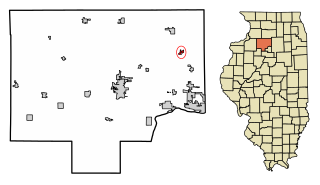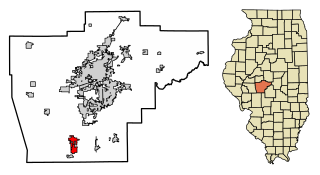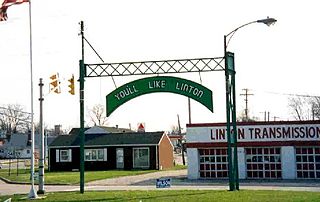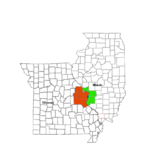
Sangamon County is a county located in the center of the U.S. state of Illinois. According to the 2020 census, it had a population of 196,343. Its county seat and largest city is Springfield, the state capital.

Macoupin County is located in the U.S. state of Illinois. According to the 2020 census, it had a population of 44,967. The county seat is Carlinville.

Arlington is a village in Bureau County, Illinois, United States. The population was 169 at the 2020 census. It is part of the Ottawa Micropolitan Statistical Area, located east of the Quad Cities, north of Peoria and Galesburg, west of LaSalle and Peru, and southwest of Rockford and Chicago.

Benld is a city in Macoupin County, Illinois, United States. The population was 1,464 at the 2020 census, down from 1,556 in 2010. It is located in the Metro-East portion of the Greater St. Louis metropolitan area.

Carlinville is a city and the county seat of Macoupin County, Illinois, United States. As of the 2020 census, the population was 5,710.

Gillespie is a city in Macoupin County, Illinois, United States, and part of the Metro East region of the St. Louis metropolitan area. The population was 3,168 at the 2020 census.

Girard is a city in Macoupin County, Illinois, United States. The population was 1,785 at the 2020 census, down from 2,103 in 2010.

Mount Olive is a city in Macoupin County, Illinois, United States. The population was 2,015 at the 2020 census. The city is part of the Metro East region within the St. Louis metropolitan area.

Staunton is the second largest city in Macoupin County, Illinois, United States. As of the 2020 census, the population was 5,054.

Toluca is a city in Marshall County, Illinois, United States. The population was 1,340 at the 2020 census. It is part of the Peoria, Illinois, Metropolitan Statistical Area.

Auburn is a city in Sangamon County, Illinois, United States. The population was 4,771 at the 2010 census, and 4,681 in 2018. It is part of the Springfield, Illinois Metropolitan Statistical Area.

Riverton is a village in Sangamon County, Illinois, United States. The population was 3,455 at the 2010 census, up from 3,062 in 2000. It is part of the Springfield, Illinois Metropolitan Statistical Area.

Braidwood is a city in Will County, Illinois, United States, approximately 53 miles (85 km) southwest of Chicago and 18 miles (29 km) south of Joliet. The population was 6,191 at the 2010 census.

Linton is a city in Stockton Township, Greene County, Indiana, United States. The population was 5,133 at the 2020 census. A coal mining city, it is located southeast of Terre Haute.

Herminie is a census-designated place (CDP) in Sewickley Township, Westmoreland County, Pennsylvania, United States. The population was 856 at the 2000 census.

The Battle of Virden, also known as the Virden Mine Riot and Virden Massacre, was a labor union conflict and a racial conflict in central Illinois that occurred on October 12, 1898. After a United Mine Workers of America local struck a mine in Virden, Illinois, the Chicago-Virden Coal Company hired armed detectives or security guards to accompany African-American strikebreakers to start production again. An armed conflict broke out when the train carrying these men arrived at Virden. Strikers were also armed: a total of five detective/security guards and eight striking mine workers were killed, with five guards and more than thirty miners wounded. In addition, at least one black strikebreaker on the train was wounded. The engineer was shot in the arm. This was one of several fatal conflicts in the area at the turn of the century that reflected both labor union tension and racial violence. Virden, at this point, became a sundown town, and most black miners were expelled from Macoupin County.
The Pana riot, or Pana massacre, was a coal mining labor conflict and also a racial conflict that occurred on April 10, 1899, in Pana, Illinois, and resulted in the deaths of seven people. It was one of many similar labor conflicts in the coal mining regions of Illinois that occurred in 1898 and 1899.

The Illinois coal wars, also known as the Illinois mine wars and several other names, were a series of labor disputes between 1898 and 1900 in central and southern Illinois.
The Carterville Mine Riot was part of the turn-of-the-century Illinois coal wars in the United States. The national United Mine Workers of America coal strike of 1897 was officially settled for Illinois District 12 in January 1898, with the vast majority of operators accepting the union terms: thirty-six to forty cents per ton, an 8-hour day, and union recognition. However, several mine owners in Carterville, Virden, and Pana, refused or abrogated. They attempted to run with African-American strikebreakers from Alabama and Tennessee. At the same time, lynching and racial exclusion were increasingly practiced by local white mining communities. Racial segregation was enforced within and among UMWA-organized coal mines.
The lynching of F. W. Stewart occurred shortly after midnight on November 7, 1898, about a mile outside of Lacon, Illinois. Stewart had been accused of the assault of a miner's daughter in Toluca. About one hundred miners formed a mob and broke into the Marshall County jail to retrieve Stewart, whom they subsequently hanged.




















